
Editorial - November 2007

November brings yet more delights. FPS Creator X10 nears publication, the convention is gone but the memories and pool of game ideas live on, a new forum board is born, and more products get an update. You'll find all of this and more in the newsletter.
The past month has been a busy one at The Game Creators, preparing for the first official convention. I have had the pleasure of working alongside them all the way, and it has been interesting to realise that there is so much happening, the only problem has been reducing the presentations to manageable sessions.
 The weekend was proof again that there is no substitute for real life, when it comes to generating ideas for games. The convention delgates spent two evenings in the company of a highly entertaining gentleman named Eric. As he served our drinks, Eric fascinated his captive audience with humorous tales and alternative views on life. Nobody escaped the sharp end of his observations, conveyed in a way you couldn't help but agree, quietly hoping he would move on swiftly to the next person. Cash Curtis II (our farthest travelling colleague), surviving only by agreeing to partake in the odd pint of Tetley's bitter to form bonds between our nations, is now considering Eric as a character in the upcoming Geisha House.
The weekend was proof again that there is no substitute for real life, when it comes to generating ideas for games. The convention delgates spent two evenings in the company of a highly entertaining gentleman named Eric. As he served our drinks, Eric fascinated his captive audience with humorous tales and alternative views on life. Nobody escaped the sharp end of his observations, conveyed in a way you couldn't help but agree, quietly hoping he would move on swiftly to the next person. Cash Curtis II (our farthest travelling colleague), surviving only by agreeing to partake in the odd pint of Tetley's bitter to form bonds between our nations, is now considering Eric as a character in the upcoming Geisha House.
until next time,

contents
(1) FPSC X10 (2) Convention (3) FPSC News (4) BOTB (5) DBPro (6) Lee's Tip of the Month (7) Hands On Winner (9) Music Tutorials (10) From the Forums (11) Winner (12) Outro
FPS Creator X10 Update

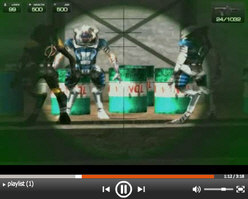 The wait is almost over! The Game Creators are now taking pre-orders for FPS Creator X10, anticipating the release in late November / early December. If you want to secure your copy for delivery as soon as it becomes available, now is the time to do so. A preview video is now showing on the MSN Soapbox site, demonstrating the fantastic power and features of the cutting-edge technology in the product.
The wait is almost over! The Game Creators are now taking pre-orders for FPS Creator X10, anticipating the release in late November / early December. If you want to secure your copy for delivery as soon as it becomes available, now is the time to do so. A preview video is now showing on the MSN Soapbox site, demonstrating the fantastic power and features of the cutting-edge technology in the product.
Take me to the pre-order page!
Development update by Lee Bamber
October has been our final development month on X10 and has been great fun watching the remaining layers of polish form on the product. Final video footage and voiceovers take the product away from it's home grown origins, to an application with a very professional feel.
We have built a translation kit using the final versions of the ingame text files, screenshots, video, images and documentation which will be used to create the mandatory EFIGS selection (English, French, Italian, German and Spanish).
The demo and example levels have been checked and rechecked to make sure they are well presented and useful, and align perfectly with the built-in manual.
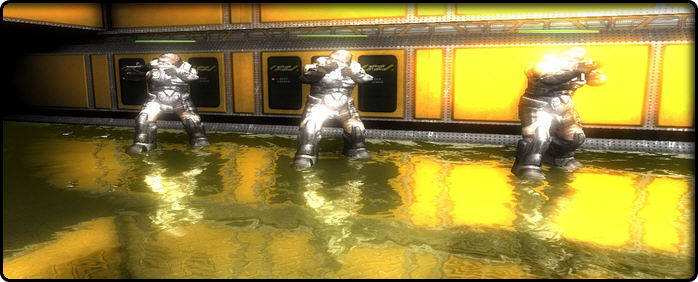
FPSC X10 brings the latest technology with the least effort
The boot menu has been created along with the additional installers for DirectX and Acrobat, so the final DVD has everything the user needs.
In order to produce a great demo game, we have gone back into the engine and made some further performance optimisations, especially around the respawning ability of characters and other dynamic entities. We also increased the stability of very small objects like keys and grenades so they no longer find their way through solid geometry.
In addition to speed ups, we have also turned sharp attention to all forms of memory leaks and driver errors. These are bugs which are very hard to spot and often silent, accounting for the most random of game problems.
We also had the opportunity to extend our engine tests to the new ATI 2900 XT cards running DirectX 10. We found that under the present drivers, they do not beat the GeForce 8800 in side-by-side tests, but are fast enough to provide a good X10 experience. There are a few issues remaining in the early ATI drivers, and we have found Catalyst 7.7 to be the most stable version, with 7.9 providing the most graphical fixes at the cost of stability. Watch this space for more news on stable drivers!
A new ghost run mode has been added to the internal system which allows a standalone game to be turned into a self-playing demo. By adding new Ghost Run Marker entities into the level, and then building those levels into a final executable, the application will run as a finished game. The title screen will be omitted, and instead it will run through each level until it reaches the final marker. It will then repeat the process for as long as the user does not enter the in-game menu. It has been a useful mode for stress testing, and ensuring a game will not freeze or crash out after hours of play.
A new weapon was recently added to the library, which we have named CHUGSHOT. When selected, the beast takes up a quarter of the screen and has animated plasma inside the visible bullet chamber. It fires a shot that yields high damage and is great for single shot combat.
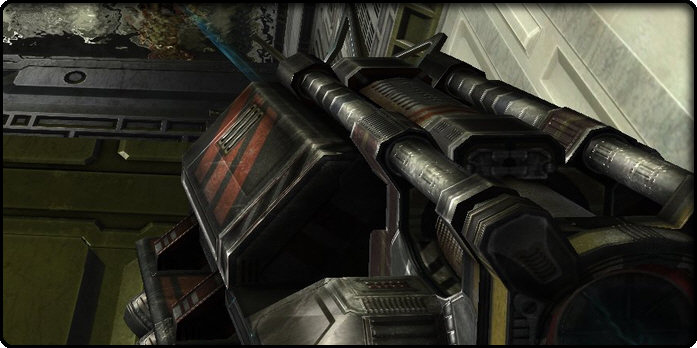
This image of the new Chugshot highlights the level of detail in every component of FPSC X10
One final feature just added is a new user generated "poster" system. This allows you to select a 2D image, import it and have it converted into a wall furniture item automatically. This will make customising your levels with your own images very easy.
Addition of new features however is at a minimum now as we charge into our final week of testing - the master is due to go off for duplication the first week of November! You will not have to wait much longer to get your hands on X10, and we hope you will have as much fun playing it as we have had creating it.
'07 - The Official Game Creators Convention
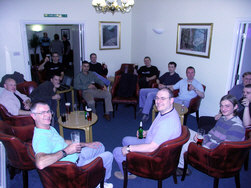 The last weekend in October saw the results of a great deal of preparations for what became a memorable event. The TGC team (Rick, Lee, Mike, Dave, Paul and Rich) gathered in one location for the first time ever in the history of the company. As well as being a highly informative session, the social aspect was also great, with a private bar and some long discussions and debates lasting until early morning. Eric, our host in the evening, will also be an honorary new character in the upcoming Geisha House (by Cash Curtis), which we also had the opportunity to preview on the conference screen.
The last weekend in October saw the results of a great deal of preparations for what became a memorable event. The TGC team (Rick, Lee, Mike, Dave, Paul and Rich) gathered in one location for the first time ever in the history of the company. As well as being a highly informative session, the social aspect was also great, with a private bar and some long discussions and debates lasting until early morning. Eric, our host in the evening, will also be an honorary new character in the upcoming Geisha House (by Cash Curtis), which we also had the opportunity to preview on the conference screen.
For those that didn't have the opportunity to attend the convention, a summary of the presentations follows. It's not possible to do justice to the work that went in to these by each of the presenters, but you will at least get a taste of what was imparted.
Rick Vanner, Financial Director
The convention provided a platform for Rick to reveal the inner workings of TGC, it's history, what is happening now, and where the company is headed. Many aspects of the company were exposed to a receptive audience, some of which only lend themselves to being announced in such an environment. Rick also spent much of his time quietly noting all of the points raised by the attendees, which will help to shape the way the company heads in the future. What follows is a summary of what was coveyed.
A history lesson
Starting with an overview of Europress and products such as STOS, 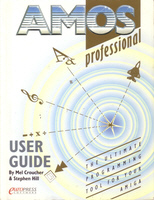 AMOS, and Klik & Play, the path towards a game-making language for the PC was starting to take root. 1997 saw the first meeting of Rick with Lee at the company, working on the Lego Mindstorms project into 1998. Although Rick planted the seed at this stage, the two went their own ways for a short while, Rick moving on to new projects while Lee continued to hone his DirectX skills in Denmark. A twist of fate led to Europress being sold to another company, circumstances turning Rick towards new ventures and finally tracked down Lee again in 2000. Dark Basic Software Limited, incorporated by Lee, was just a few months old by this time.
AMOS, and Klik & Play, the path towards a game-making language for the PC was starting to take root. 1997 saw the first meeting of Rick with Lee at the company, working on the Lego Mindstorms project into 1998. Although Rick planted the seed at this stage, the two went their own ways for a short while, Rick moving on to new projects while Lee continued to hone his DirectX skills in Denmark. A twist of fate led to Europress being sold to another company, circumstances turning Rick towards new ventures and finally tracked down Lee again in 2000. Dark Basic Software Limited, incorporated by Lee, was just a few months old by this time.
Between its conception and today, the company drew in Mike Johnson, Rich Davey, Dave Milton and Paul Johnston. Simon Benge also dedicates much of his time to the artistic requirements of the company. Product-wise, various titles have been born from the need to support the company structure, and to maintain the required skillset through the right mix of people. Products such as Driving Test Success Practical - which in turn generated a need for Dark Physics - have added value to the core products, as new functionality has been driven by these applications. A natural progression brought us FPS Creator, Dark Lights, Dark AI and many more affordable development tools.
The present
Interesting insights into the working structure of the company were also presented. Everyone in the TGC team works from home, giving freedom on the hours people work, and allowing for extended coding sessions into the night when they become necessary! Some progress can be hampered by this, but it generally has more pros than cons. It is comforting to know that TGC is intentionally a small company, with stability in the format the business has created over the years. Freelancers complete the peripheral requirements to ensure products receive the attention needed in all areas. As a side note, knowing that professional companies such as TGC accept long timeframes and significant bug-quashing sessions as normal and part of the development process, will be welcome news to coders who feel victimised by their own creations!
The future
FPSC Creator users will shortly benefit from TGC Store, a shopfront built into the game editor. From here, models, media and other resources will be easily accessible, and continually updated. The finer details are being developed right now, but ultimately the productive, skilled members of the community will be able to use this as an outlet for their own creations, opening up a huge new market place. TGC is interested in maintaining a healthy market for indie game developers, and Rick explained the different ways one can go to market with a product. The pros and cons of publishing deals, including the overwhelming expectations placed on developers is valuable knowledge, and puts the ability to self-publish through TGC Store, the Internet and commission-based independent outlets in perspective.
The Game Creators has reached a stage in it's life where branding has become a key property. As the name continues to add value to the company, it is important that the products reciprocate the effect and maintain the brand through future updates and evolution. New technology will continue to find it's way into the applications, as we have seen over the years. The prime example of this is FPSC X10, which will ultimately result in DarkBASIC Professional X10, once the new functions have been embedded as permanent features of the language.
In conclusion...
To summarise, TGC are busier than they have ever been, the future of the products we are familiar with continue to receive the loving attention of the team, and the additional titles that we see from time to time contribute to a successful and stable company alongside the introduction of new features in the core products. Everything seen leaving the doors of the company is an indication that the basic offerings are continuing to improve in functionality and quality.
Lee Bamber, TGC Lead Developer
Everyone knows what Lee is doing through his timely updates each month in the FPS Creator X10 column. To add to the insight we already have, yet more was revealed of the features that the product will contain. In all, fifteen months of rigorous development, testing and responding to the demands of today's gamers have resulted in FPSC X10, which is available to pre-order now.
Although the company expected to release the title much earlier, the wise decision was made to hold back and ensure expectations are fulfilled. The net effect is better AI, better character models and scenery, and a more polished result. Looking back, the team can be confident that the right decisions have been made. FPS Creator is a growing brand and is here for the long-haul.
So what can we expect to see? Additional features include:
- more DirectX 10 effects, including parallax shaders (more depth from 2D textures)
- inbuilt video tutorials and sample games
- auto-updates of the software
- more FPI scripting commands
- additional media
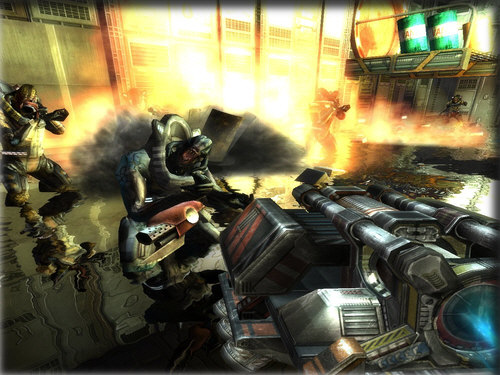
FPSC X10 is imminent!
Essentially, owners will be making X10-enabled games before major publishers, and before the onslaught of AAA titles hit the market. As the market turns to DirectX 10, the TGC store will provide access to further media, scripts, game levels and more, keeping your productions fresh and up to date.
The rumours surrounding DarkBASIC Professional
Turning to DarkBASIC Professional, Lee has assured all concerned that it is happening, and it's happening as a consequence of the hard work put into FPSC X10. The language is not in a state to publish, and many functions created now need to be fine-tuned and made to work in a more generic environment. Predictions are that 2008 will see a new era for the language.
The current version has - as a result of the convention and discussions that ensued - undergone a few enhancements. Lee took home a significant list of requests which warranted some investigation, and promptly implemented many of the suggestions. Indirectly, the whole community will see the benefits of the weekend, and Lee expressed his appreciation of the dedication to DB Pro of its users by responding. Many other ideas were bounced around during the weekend and these have been duly noted for future reference.
Mike Johnson
The GDK is the platform of choice for C++ developers. It opens up the DarkBASIC Professional command set and enables 3D interaction, in an environment that many programmers are already familiar with long before they delve into the GDK libraries. It ships with a number of standard Win32 project templates and 14 demonstrations of the features, including a full FPS game and Space Invaders to accompany the comprehensive beginner's tutorial. Sunday morning at the Convention started with Mike Johnson taking an alternative look at the GDK and how it can be used in conjunction with other libraries and resources to great effect.
The key feature highlighted in the GDK is the direct access to the functionality behind the commands we are familiar with as DarkBASIC Professional developers. As the standard commands contain a wealth of necessary checks (which ensure our games are stable and reliable), direct access allows faster programs to be created by those who are happy to bypass these safeguards.
Direct access has other advantages too. Mike's presentation centred around a small project to load World Of Warcraft characters into his own application. For those of you that don't know, Mike is a huge WoW fan, so dedicating his time to such a task isn't too much of a chore!
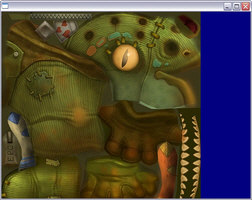
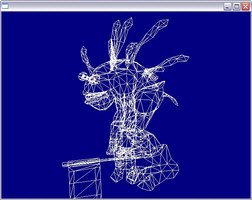
Extracting the textures, followed by the mesh construction
As well as the technicalities of such a process, it was interesting to see just how the full design and development pipeline is constructed. This includes research into the file formats to gain a comprehensive understanding of the undertaking initially. From this stage, other, freely available libraries are drafted in to extract the compressed files from their archives, and build up the resources needed to complete the task at hand. Bringing in the power of GDK to assist, the model, it's textures and animations are reconstructed.
The conclusion of the presentation was a WoW character walking across the screen, fully textured and cycling through over 40 different animation sequences. What's more, this can all be saved in the proprietary dbo format ready for another day.
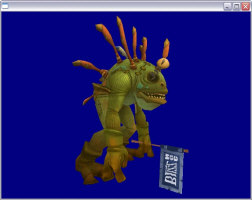
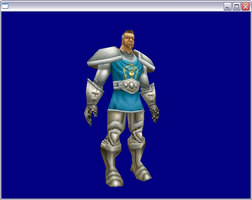
The completed Murloc, and applying the same principles to another WoW character
Dave Milton
Affectionately know as Ravey, Dave introduced the gathering to some of his secret projects. As reported last month, he is currently working on a product known as HD DVD Game Studio. It is too early to release many details as yet, but this will develop into an application enabling the generation of deeply immersive and interactive content, making full use of higher resolutions and data bandwidth.
Dark Invaders also featured, which on the face of things looks like a very simple, classic invaders game. You would be correct in assuming all of the above. It is, however, the central focus of a very detailed Dark GDK tutorial, designed for newcomers to the concept of coding for games. The tutorial will make a public appearance in the near future, and is part of a renewed focus on assisting new users of TGC products.
 The bulk of Dave's presentation concentrated on the technicalities of bringing the latest Driving Test Success Practical 2 title to fruition. It is safe to say that the majority of onlookers were in awe of the techniques used to create such a complex product. We were gently introduced to the idea of generating road meshes from splines. In layman's terms, this involves drawing a line, bending it under certain mathematical rules to make it smooth and consistent, finally overlaying the curve with a mesh to form the road. The demonstration illustrated the phenomenal speed at which this can be done, literally throwing around a textured model made up of hundreds of vertices as if it was a piece of string. As technically complex as it looked, it became more impressive to find that the methodologies employed are accessible to users of DarkBASIC Professional and DarkGDK users via the use of memblocks.
The bulk of Dave's presentation concentrated on the technicalities of bringing the latest Driving Test Success Practical 2 title to fruition. It is safe to say that the majority of onlookers were in awe of the techniques used to create such a complex product. We were gently introduced to the idea of generating road meshes from splines. In layman's terms, this involves drawing a line, bending it under certain mathematical rules to make it smooth and consistent, finally overlaying the curve with a mesh to form the road. The demonstration illustrated the phenomenal speed at which this can be done, literally throwing around a textured model made up of hundreds of vertices as if it was a piece of string. As technically complex as it looked, it became more impressive to find that the methodologies employed are accessible to users of DarkBASIC Professional and DarkGDK users via the use of memblocks.
DTSP 2 relies on a suite of editors, created specifically for this application. Again, the detail of the session illustrated methods that can be employed by the average programmer who is dedicated to producing impressive but realistically achievable results. Dropping in buildings, lampposts and other street furniture is no longer laborious when the editor is designed to ease the task.
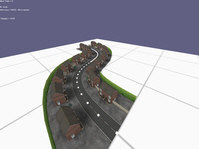
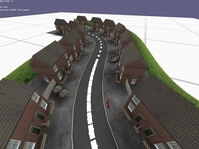
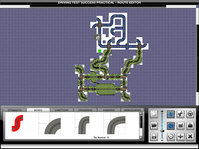
Rapid development of worlds using spline-based roads
Tips and tricks of the language revealed how such large outdoor scenarios are achieved in the product. Considering a user can drive around a town (and countryside) for thirty minutes or more, optimisation is key to the success. Visibility techniques show and exclude the relevant parts of the map, whilst complex model animation is reduced to simple mathematics when not in view.
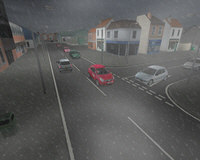 The Artificial Intelligence of the traffic is second to none, and we would have needed a full week to understand how DTSP 2 Robocars (automated drivers) obey the Highway Code, know how and when to cross oncoming traffic to turn into new roads, overtake and cope with all other scenarios the average driver faces every day. The traffic is fully alive, and a user of the product will never encounter the same scenario twice.
The Artificial Intelligence of the traffic is second to none, and we would have needed a full week to understand how DTSP 2 Robocars (automated drivers) obey the Highway Code, know how and when to cross oncoming traffic to turn into new roads, overtake and cope with all other scenarios the average driver faces every day. The traffic is fully alive, and a user of the product will never encounter the same scenario twice.
The final piece of the jigsaw comes in the form of Lua scripts to enable the objectives in the application. Performing the necessary manoeuvres and tests is vastly improved in the new release of this popular title, thanks to the scripted intelligence. The user builds up a set of tasks (such as braking and checking mirrors), and the engine allows for the natural and expected variations in response times and relationships between tasks. Driving Test Success Practical is as close as you can get to taking your driving test without getting in a car, it's due for release in November from Focus Multimedia.
Paul Johnston
Over the past few months, Paul has been quietly adding improved functionality to the FPSC X10 pipeline. Where lighting was once a drain on resources during game build, it is now far more efficient. Users of the original FPSC will be familiar with the odd enemy that isn't scared of gunshot ringing in his ears, and is happy to walk into walls. Paul has resolved these issues with improved AI, which also includes more clever features, such as avoiding small collections of motionless carcasses.
Threads, Mutexes and Grains of Wisdom
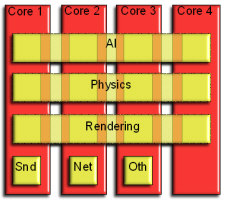 Some of the techniques used to allow these features to be used were explained and unravelled at the convention. Threading is the main reason for improved performance, and has found it's way into Dark Lights and Dark AI, both used in FPS Creator X10. As much as I would have liked to say I understand the benefits of this methodology, Paul's experience takes us much further into coding design, and understanding how unknown quantities of cores can be tapped for power and efficiency. Rather than offload specific tasks on to additional cores, a combination of such an approach and additionally offloading smaller pieces of larger processes is used to utilise as many processors as there are available.
Some of the techniques used to allow these features to be used were explained and unravelled at the convention. Threading is the main reason for improved performance, and has found it's way into Dark Lights and Dark AI, both used in FPS Creator X10. As much as I would have liked to say I understand the benefits of this methodology, Paul's experience takes us much further into coding design, and understanding how unknown quantities of cores can be tapped for power and efficiency. Rather than offload specific tasks on to additional cores, a combination of such an approach and additionally offloading smaller pieces of larger processes is used to utilise as many processors as there are available.
Mutexes are no longer just a strange term for something that cannot be understood. The ingenious use of simple practices ensures the game stays finely tuned and in control. The amalgamation of this and the various other designs keep FPSC X10 ahead of the game.
Prize Winners
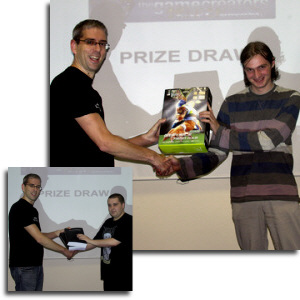
A draw held on the Saturday evening resulted in Michael (Mson) leaving with a brand new NVIDIA graphics card. Andrew (Mnemonix) had the pleasure of adding a huge weight to his luggage, with the very large Hands-On books.
News from the World of FPS Creator


The Avanti Vista skyboxes create backgrounds for your levels or scenes, which make your world look bigger than it really is, by creating the illusion of distant three-dimensional surroundings.
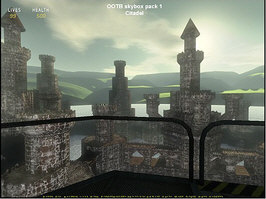
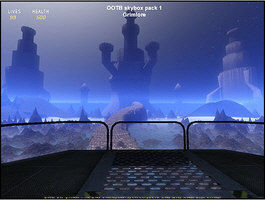
Each of the two sets comprises 16 sky boxes, ideal for both FPSC and DarkBASIC projects. Each skybox scene comes with six 1024x1024 high reslution images. They also come with ready made cubes, textured and in both .obj and .x format. The textures can also be used for cube and sphere mapping effects.
The skyboxes are available from the Avanti Vista website, and there is also a lower resolution sample for you to freely download.
Best Of The Best

BOTB Badges
The current award winners were decorated with their badges this month, and you will be able to recognise them instantly as our most productive and imaginitive users of FPS Creator to date. Creator of Zombies adds his name to the ranks this month, with Demon Sun.
Demon Sun
by Creator of Zombies
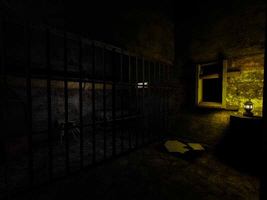 Demon Sun is based in a remote city which has been subjected to biological attack. Retired SAS officer Paul Baker is caught up within the chaos, the blast knocking him out. Paul awakes some hours later, lying in an abandoned office that was once the centre of a Goverment run chemical research plant. With no knowledge of the past events, Paul must uncover the truth.
Demon Sun is based in a remote city which has been subjected to biological attack. Retired SAS officer Paul Baker is caught up within the chaos, the blast knocking him out. Paul awakes some hours later, lying in an abandoned office that was once the centre of a Goverment run chemical research plant. With no knowledge of the past events, Paul must uncover the truth.
"While watching a horror film one night, I thought 'Why not gather all of the director's horror tips and designs, and create an FPS game?'. So, with this idea in mind, I purchased over 10 horror DVDs from ebay, and began to create checklists of what techniques the director used to scare the audience. But this wasn't enough; I needed further test material.
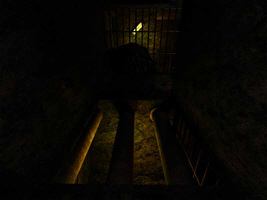 "Next, I dug out all my old horror games from the PS1 and PC, and began to play them. After many hours of playing and writing, I had composed a list of level design techniques, atmosphere creation tips, and pointers on sound placement. Finally, I made contact with some mates who had first hand experience of level design and game creation (in C++ and other languages). They gave me their advice, which I then added to my ever growing list.
"Next, I dug out all my old horror games from the PS1 and PC, and began to play them. After many hours of playing and writing, I had composed a list of level design techniques, atmosphere creation tips, and pointers on sound placement. Finally, I made contact with some mates who had first hand experience of level design and game creation (in C++ and other languages). They gave me their advice, which I then added to my ever growing list.
"Now that I had all the infomation I needed, it was time to start creating. After MANY re-designs of levels, and many texture alterations, I finally had the base for what I like to call...Demon Sun.
You can download the game here.
DarkBASIC Professional Round-up

DarkBASIC Classic upgrade 1.2 is now available on the site. As mentioned last month, the new release provides better support for games produced in Windows Vista. The changes include the removal of DirectX retained mode dependency and the way that temporary files are generated.
Four new commands have also been added to provide better lighting and material effects to objects.
- SET OBJECT DIFFUSE - describes how much diffuse light an object will reflect
- SET OBJECT AMBIENT - describes how much ambient light an object will reflect
- SET OBJECT SPECULAR - describes how an object reflects light and appears shiny
- SET OBJECT EMISSIVE - describes how an object emits light for self-lumination
The latest version of the product can be found on the DarkBASIC Classic pages, alongside the full specification and capabilities of the language. Existing users can download the upgrade installation package.
EZrotate update for DarBASIC Professional and DarkGDK
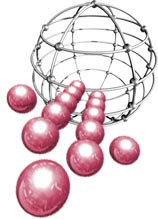
EZrotate Enhanced was one of the first official addon packs released for DarkBasic Professional. Now, over three years later, EZrotate has been completely rebuilt to make it bigger and badder than ever!
When EZrotate was first released it added 45 new commands to DarkBasic Professional. Now, there are over 100 commands!
There were two main purposes of this update:
- Make it easier to use.
- SPEED!
To make the core functionality easier to use, direct interaction of objects and cameras is added to this update. Before, these are the steps that you would have to make with EZrotate to rotate your object on it's global X axis:
`1) Setup EZrotate with your object's current rotation EZro_SetEuler Object Angle X( ObjNo ), Object Angle Y( ObjNo ), Object Angle Z( ObjNo ) `2) Apply rotation to your object EZro_GX angle# `3) Calculate new Euler Angles EZro_FindEuler `4) Apply the new orientation to your object Rotate Object ObjNo, EZro_GetEulerX(), EZro_GetEulerY(), EZro_GetEulerZ()
As easy as this is in comparison to mathematical calculations, now you can do all of this in one simple step!
EZro_ObjGX ObjNo, angle#
This will make things far easier to work with for most applications. The flexibility of the old method is still intact too, so the best of both worlds is now available.
The second goal of the update was speed. The internals of EZrotate are completely rebuilt and every attempt made to squeeze every last bit of performance out of all commands. It is safe to say that every command is now faster than it was. Many commands are in the vicinity of 20 to 30 times faster!
EZrotate has also been updated for GDK use. It takes advantage of all the speed increases that are found in the new DarkBasic Professional version. It currently does not have the commands to work directly with objects and cameras, but that may come soon!
The update will become available in the first few days of November. Current owners of EZrotate Enhanced receive version 4 for DarkBasic Professional and GDK at no additional cost - check your order history for the download. New users of the plug-in can visit the product page to make their purchase.
Lee's Tip of the Month - Need For Speed
How many times have you finished a game only to find it is too slow to play? It used to be fast, you remember that much. Somewhere along the way the speed fairy came along and sucked the life out of your game, and now you are playing a series of screenshots.
What usually happens is the game gets full of all the things it needs to distinguish itself from being a technical demo. All these little details that by themselves seem innocent enough, but group together to form little pockets of slowness that very soon bring your game to it's knees.
There are many tricks to speed up, or optimise, your game. They usually revolve around the concept of doing less, doing it earlier and doing it over time. The main problem you have is that your game is probably doing too much, doing it in the middle of your main loop and doing it all at once.
Doing less could mean keeping down the number of enemies to a level, or simplifying a complex mechanism in the game. Often you will find ways to remove elements from your game without sacrificing the gameplay, and it is often the simplified elements that contribute the most to gameplay.
Doing things earlier in your game could mean moving complex calculations to execute before your main loop, storing the results in an array and using those values within the game itself. A typical example of this would be working out rotation vectors for a game that requires angles:
BEFORE:
DO X#=X#+COS(A#)*5.0 Y#=Y#+SIN(A#)*5.0 DOT X#,Y#,1 LOOP
AFTER:
DIM ANGLES(360,1) AS FLOAT FOR A=0 TO 360 ANGLES(A,0)=COS(A)*5.0 ANGLES(A,1)=SIN(A)*5.0 NEXT A
DO X#=X#+ANGLES(A,0) Y#=Y#+ANGLES(A,1) DOT X#,Y#,1 LOOP
Although the code seems bigger, in terms of game performance the second program is significantly faster as the look-up for COS() and SIN(), plus a multiply command are all performed in advance, allowing the actual game loop to call a very fast array read instead.
Doing something over time is about slicing up your calculations into manageable chunks, and spreading those tasks across multiple cycles within your main loop. Taking the above problem, a solution using this technique might be:
DIM ANGLES(360,2) AS FLOAT DO IF ANGLES(A#,2)=0 ANGLES(A#,0)=COS(A#)*5.0 ANGLES(A#,1)=SIN(A#)*5.0 ANGLES(A#,2)=1 ENDIF ` X#=X#+ANGLES(A#,0) Y#=Y#+ANGLES(A#,1) DOT X#,Y#,1 LOOP
This code will calculate the required COS() SIN() data once, and then use the results the next time it is required. This program will be faster during the initialisation step, but there will be a slight performance hit each time the angle is changed, but only once.
Although these examples have been simplified, the concepts behind them are very useful, and could mean the difference between abandoning a game that is too slow, and releasing your first game!
Hands On DarkBASIC Professional Cover Design Winner
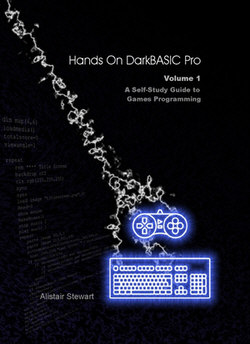 Neil King (more commonly known as Zappo) is the winner of the competition to design a new cover for this popular book.
Neil King (more commonly known as Zappo) is the winner of the competition to design a new cover for this popular book.
It was a very close call and quite difficult to make the final decision, but in the end it was Neil's design which got the vote. Whilst some of the other designs were excellent, they did not all convert to covers quite as well once the text was laid over. Alistair and his team would like to thank the other four finalists for their amazing efforts and time put into this competition.
They were:
- Mike Inel
- Erico Monteiro
- Joe Lubbehusen
- Joshua Tenderholt
You can buy this and volume 2 from the product pages, although the new design will not be available until the next production run.
Music Tutorials
The new Music and Effects forum (see From the Forums for more details) has already spawned two very well written and just as well received tutorials. Written by Lucifer, they lay out the basic concepts behind FL Studio, a popular Digital Audio Workstation. To give you a flavour of these educational threads, here is an excerpt from the second publication Lucifer has put his hand to.
Making sound Effects
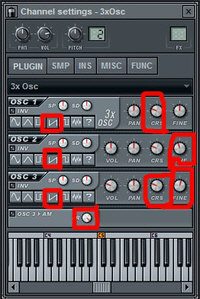 In this tutorial I'll show you how to make a very cool 3xOsc Saw sound by using Effects and the 3xOsc; we'll start with the 3xOsc.
In this tutorial I'll show you how to make a very cool 3xOsc Saw sound by using Effects and the 3xOsc; we'll start with the 3xOsc.
I dont think I need to explain the 3xOsc synth again, but if you need to remind yourself what it is, check out the first tutorial.
Set the 3xOsc synth as shown, and make sure all the CRS are tuned correctly, this will sound horrible if not. You dont need to move the middle slider, just the top and bottom ones. Tune them exactly to the position of the middle one.
When you've done that, try the little keyboard (piano) on the bottom of the synth and see how it sounds. it should have a very technoish sawy sound. But it lacks the key part of it all, the effects. Next, I'm going to show you how to add these effects.
In the left corned of the 3xOsc synth is a little button, click it, and then click "assign free mixer channel". This will open up the mixer, it is there where you add effects. You can also open the mixer by clicking the button highlighted in the image.
Adding effects is really easy, it is getting them to sound correct that is the tricky part. You add effects by pressing the effects menu button (the one with the "down" arrow symbol), moving the mouse over the select option and then choosing the preferred effect. You can select up to 8 effects on each mixer track (for each synth). I want you to select these effects on the current mixer track (mixer track 2, the one the 3xOsc is assigned to) select the Flanger , Paramedic EQ 2, and Reverb.
Full tutorials
This complete tutorial, and the more basic introductory one can be found on the forums:
From the Forums
New boards and new tools feature this month on the forums.
Tutorial Overload
Zotoaster has refreshed the growing array of tutorials that are available out there, written by a diverse range of users for the benefit of the masses. It is the place to start, and whatever your background you'll find something useful.
Synergy Editor
John Youren needs your feedback to ensure Synergy Editor meets the needs of the users, and is a stable IDE for your project development. This is a lightweight editor, designed to make coding simple.
.
New Music and FX Board
As the community grows over time, so do the small pockets of talent in more specialised areas. We now have a significant number of musically oriented people, and a natural following of developers in need of music to warrant a new board.
2D Physics Engine
Diggsey is working on, and rapidly improving a wrapper for 2D Physics. It provides access to the functionality of Box2D, an opensource API dedicated to this area of game production. This thread is very active right now, and stirring interest.
.
This month's Winner
Each month we pluck one lucky subscriber from the newsletter mailing list and award them a free copy of DarkBASIC Professional. The email address of this month's winner is: ted**b**rjoe21**@yahoo.com If this is you then send us an email to claim your prize.
Outro
Share your news with over 14,000 active games developers!
If you have something you'd like featured in a future issue then please get in touch and include as much information as possible (including where applicable: screen shots, URLs and zip files).
Issue 59 deadline - November 27th.
Memorable convention Quotes, by Lee Bamber:
"I really don't mind the blue crash screens, it means I am on the cutting edge of technology"
"I ain't going to be the cow!"
(on being cornered in a bar, referring to the food dropped in the cage at the beginning of Jurassic Park).












